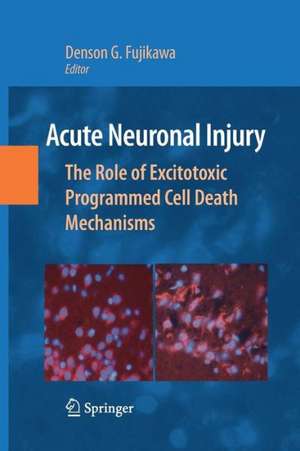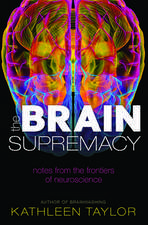Acute Neuronal Injury: The Role of Excitotoxic Programmed Cell Death Mechanisms
Editat de Denson G. Fujikawaen Limba Engleză Paperback – 5 sep 2014
The Second Edition contains 11 thoroughly updated chapters and 3 additional chapters that did not appear in the previous edition.
| Toate formatele și edițiile | Preț | Express |
|---|---|---|
| Paperback (2) | 554.05 lei 38-44 zile | |
| Springer International Publishing – 14 dec 2018 | 554.05 lei 38-44 zile | |
| Springer Us – 5 sep 2014 | 1375.87 lei 6-8 săpt. | |
| Hardback (1) | 643.34 lei 6-8 săpt. | |
| Springer International Publishing – 19 sep 2018 | 643.34 lei 6-8 săpt. |
Preț: 1375.87 lei
Preț vechi: 1677.89 lei
-18% Nou
Puncte Express: 2064
Preț estimativ în valută:
263.30€ • 285.91$ • 221.18£
263.30€ • 285.91$ • 221.18£
Carte tipărită la comandă
Livrare economică 22 aprilie-06 mai
Preluare comenzi: 021 569.72.76
Specificații
ISBN-13: 9781489982858
ISBN-10: 148998285X
Pagini: 320
Ilustrații: XII, 306 p.
Dimensiuni: 155 x 235 x 17 mm
Greutate: 0.45 kg
Ediția:2010
Editura: Springer Us
Colecția Springer
Locul publicării:New York, NY, United States
ISBN-10: 148998285X
Pagini: 320
Ilustrații: XII, 306 p.
Dimensiuni: 155 x 235 x 17 mm
Greutate: 0.45 kg
Ediția:2010
Editura: Springer Us
Colecția Springer
Locul publicării:New York, NY, United States
Public țintă
Professional/practitionerCuprins
Caspase-Independent Programmed Cell Death: General Considerations.- Caspase-Independent Cell Death Mechanisms in Simple Animal Models.- Programmed Necrosis: A “New” Cell Death Outcome for Injured Adult Neurons?.- Age-Dependence of Neuronal Apoptosis and of Caspase Activation.- Excitotoxic Programmed Cell Death Involves Caspase-Independent Mechanisms.- Focal Cerebral Ischemia.- Significant Role of Apoptosis-Inducing Factor (AIF) for Brain Damage Following Focal Cerebral Ischemia.- The Role of Poly(ADP-Ribose) Polymerase-1 (PARP-1) Activation in Focal Cerebral Ischemia.- Transient Global Ischemia.- Transient Global Cerebral Ischemia Produces Morphologically Necrotic, Not Apoptotic Neurons.- Apoptosis-Inducing Factor Translocation to Nuclei After Transient Global Ischemia.- Role of µ-Calpain I and Lysosomal Cathepsins in Hippocampal Neuronal Necrosis After Transient Global Ischemia in Primates.- Traumatic Central Nervous System (CNS) Injury.- Mitochondrial Damage in Traumatic CNS Injury.- Programmed Neuronal Cell Death Mechanisms in CNS Injury.- Hypoglycemic Neuronal Death.- Hypoglycemic Brain Damage.- Hypoglycemic Neuronal Death.- Seizure-Induced Neuronal Death.- Tumor Suppressor p53: A Multifunctional Protein Implicated in Seizure-Induced Neuronal Cell Death.- DNA Damage and Repair in the Brain: Implications for Seizure-Induced Neuronal Injury, Endangerment, and Neuroprotection.- Activation of Caspase-Independent Programmed Pathways in Seizure-Induced Neuronal Necrosis.
Recenzii
“This is an outstanding book concerning the molecular and cellular mechanisms of trauma and ischemia in the mammalian brain. … I recommend his book to neurophysiologists, neurologists, and neurosurgeons.” (Joseph J. Grenier, Amazon.com, September, 2015)
Notă biografică
Dr. Denson Fujikawa is an Adjunct Professor of Neurology at the David Geffen School of Medicine at UCLA, a member of the Brain Research Institute at UCLA and a Staff Neurologist at the Department of Veterans Affairs Greater Los Angeles Healthcare System. His interest in mechanisms of nerve cell death in the brain began during a two-year epilepsy research fellowship with Dr. Claude Wasterlain, from 1981 to 1983. He is a Fellow of the American Academy of Neurology and is a member of the American Epilepsy Society, American Neurological Association, International Society for Cerebral Blood Flow and Metabolism and the Society for Neuroscience.
Textul de pe ultima copertă
This book is the result of a convergence of scientific information regarding mechanisms that produce acute nerve cell death in the brain. Although seemingly disparate, stroke, brain and spinal cord trauma, coma from a low serum glucose concentration (hypoglycemia), and prolonged epileptic seizures have in common the inciting factor of excitotoxicity, the activation of a specific subtype of glutamate receptor by an elevated extracellular glutamate concentration that results in an excessive influx of calcium into nerve cells. The high calcium concentration in nerve cells activates several enzymes that are responsible for degradation of cytoplasmic proteins and cleavage of nuclear DNA, resulting in nerve cell death. The high calcium concentration also interferes with mitochondrial respiration, with the resultant production of free radicals that damage cellular membranes and nuclear DNA. Understanding the biochemical pathways that produce nerve cell death is the first step toward devising an effective neuroprotective strategy, the ultimate goal.
Acute Neuronal Injury will be useful to neuroscientists and general cell biologists interested in cell death. The book will also be helpful to clinically oriented neuroscientists, including neurologists, neurosurgeons and psychiatrists.
About the Editor:
Dr. Denson Fujikawa is an Adjunct Professor of Neurology at the David Geffen School of Medicine at UCLA, a member of the Brain Research Institute at UCLA and a Sta
ff Neurologist at the Department of Veterans Affairs Greater Los Angeles Healthcare System. His interest in mechanisms of nerve cell death in the brain began during a two-year epilepsy research fellowship with Dr. Claude Wasterlain, from 1981 to 1983. He is a Fellow of the American Academy of Neurology and is a member of the American Epilepsy Society, American Neurological Association, International Society for Cerebral Blood Flow and Metabolism, and the Society for Neuroscience.
Acute Neuronal Injury will be useful to neuroscientists and general cell biologists interested in cell death. The book will also be helpful to clinically oriented neuroscientists, including neurologists, neurosurgeons and psychiatrists.
About the Editor:
Dr. Denson Fujikawa is an Adjunct Professor of Neurology at the David Geffen School of Medicine at UCLA, a member of the Brain Research Institute at UCLA and a Sta
ff Neurologist at the Department of Veterans Affairs Greater Los Angeles Healthcare System. His interest in mechanisms of nerve cell death in the brain began during a two-year epilepsy research fellowship with Dr. Claude Wasterlain, from 1981 to 1983. He is a Fellow of the American Academy of Neurology and is a member of the American Epilepsy Society, American Neurological Association, International Society for Cerebral Blood Flow and Metabolism, and the Society for Neuroscience.
Caracteristici
Presents the most up-to-date information on all aspects of excitotoxic neuronal death Includes supplementary material: sn.pub/extras












